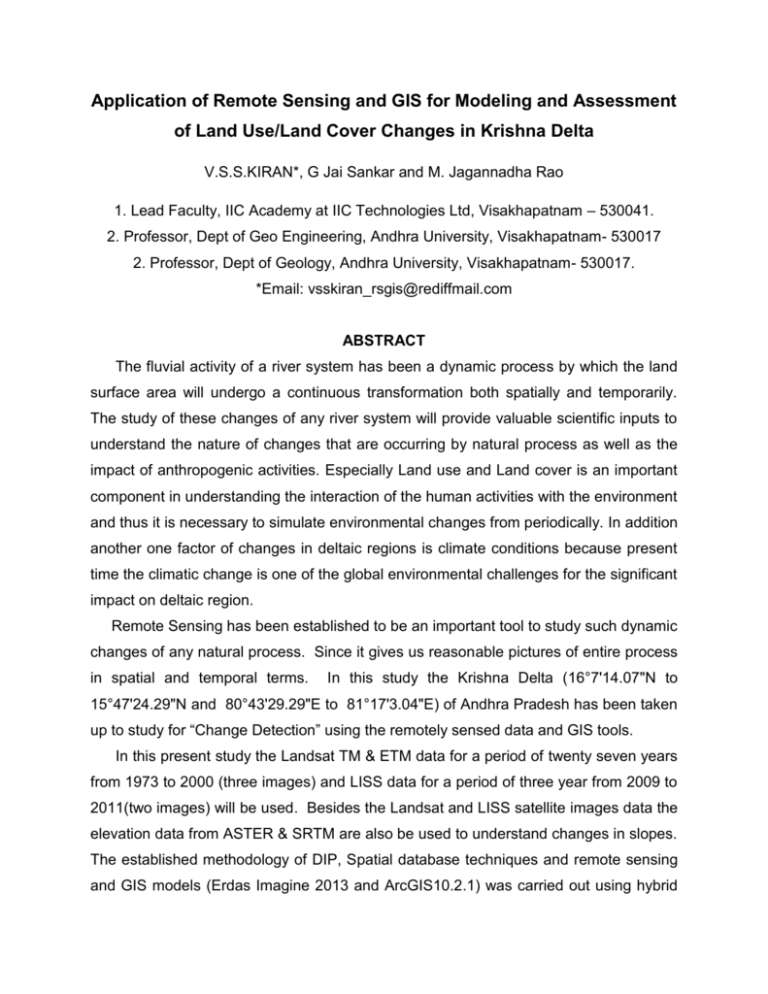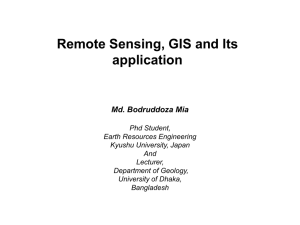Application of Remote Sensing and GIS for Modeling
advertisement

Application of Remote Sensing and GIS for Modeling and Assessment of Land Use/Land Cover Changes in Krishna Delta V.S.S.KIRAN*, G Jai Sankar and M. Jagannadha Rao 1. Lead Faculty, IIC Academy at IIC Technologies Ltd, Visakhapatnam – 530041. 2. Professor, Dept of Geo Engineering, Andhra University, Visakhapatnam- 530017 2. Professor, Dept of Geology, Andhra University, Visakhapatnam- 530017. *Email: vsskiran_rsgis@rediffmail.com ABSTRACT The fluvial activity of a river system has been a dynamic process by which the land surface area will undergo a continuous transformation both spatially and temporarily. The study of these changes of any river system will provide valuable scientific inputs to understand the nature of changes that are occurring by natural process as well as the impact of anthropogenic activities. Especially Land use and Land cover is an important component in understanding the interaction of the human activities with the environment and thus it is necessary to simulate environmental changes from periodically. In addition another one factor of changes in deltaic regions is climate conditions because present time the climatic change is one of the global environmental challenges for the significant impact on deltaic region. Remote Sensing has been established to be an important tool to study such dynamic changes of any natural process. Since it gives us reasonable pictures of entire process in spatial and temporal terms. In this study the Krishna Delta (16°7'14.07"N to 15°47'24.29"N and 80°43'29.29"E to 81°17'3.04"E) of Andhra Pradesh has been taken up to study for “Change Detection” using the remotely sensed data and GIS tools. In this present study the Landsat TM & ETM data for a period of twenty seven years from 1973 to 2000 (three images) and LISS data for a period of three year from 2009 to 2011(two images) will be used. Besides the Landsat and LISS satellite images data the elevation data from ASTER & SRTM are also be used to understand changes in slopes. The established methodology of DIP, Spatial database techniques and remote sensing and GIS models (Erdas Imagine 2013 and ArcGIS10.2.1) was carried out using hybrid classification approach NDVI techniques, Masking techniques and classifications techniques i.e. supervised and unsupervised are used to generate data on land use/land cover changes. The data generated in the form of various output maps, comparative graphs and DEMS have been presented in this paper. In addition the Statistics generated from satellite remote sensing data helped in understanding the physical process and changes in land use/land cover in space and time variation. The most important geological considerations and factors controlling the fluvial system resulted various changes have been brought out. The paper established that the right combination of RS & GIS techniques could be perfectly used for the change detection studies. Keywords: Remote Sensing, GIS, DIP, Landsat TM & ETM, ASTER/SRTM. INTRODUCTION: out from the different periods of remote We aware of every day the change is sensing satellite data. coming in environment. Faster, slower, ABOUT THE STUDY AREA: or going in circles, it is the biggest The study area relates to the deltaic constant in our world. An attained a region located in Krishna district and couple things that are already in Remote Andhra Pradesh state. Study area is sensing covered environment, understanding much more that makes at 16°7'14.07"North imagery and change 15°47'24.29"North palatable. In Remote 80°43'29.29"East latitudes to to and 81°17'3.04"East sensing the change detection is an longitudes. The mouth of Krishna River important application to gain knowledge is about the geographical changes. It is a Andhra Pradesh. The delta of this river method to find out the changes of is one of the most fertile regions in India specific features within a certain time and period. During this period, the change Satavahana and Ikshvaku Sun Dynasty detection application provides spatial kings. distribution of features and detailed METHODOLOGY: information of its changes, which carried The methodology is derived into the Hamsaladeevi, was the Krishna home to district, ancient different parts i.e. Data collection, Geo- referencing, Data Erdas Imagine 2013 was used to create Use/Land Cover land use/ land cover maps of all years Analysis, LU/LC and ArcCatalog 10.2.1 was used to Area calculation, Land use/ Land cover create GeoDatabases to store datasets change detection using GIS statistical and the results of analysis. models & Image Subtraction method, Geo Referencing & Projection: Surface Analysis etc. All Data Collection: corrected using some ground control For this present study the several GPS points and the SOI base points in datasets were required the objective and aim. preparation, projection, Land classification, Data to Data reach themes collected software data of is geometrically ArcGIS 10.2.1. Resourcesat and Landsat satellite data georeferenced cover classes like Lake, Water Body, polynomial method and double imagery Heavy Dense Forest, Medium Dense rectification process. Forest, Open Forest, Sand Deposition, The data used for the analysis were all Wet land, Agriculture Land, Aquaculture projected using the Global Coordinate Land and Settlement etc. The 1973, System 1990 and 2000 Tm & Etm plus landsat Projected Coordinate system “Universal satellite datasets were downloaded from Transverse Mercator” projection system the with 44 North zone and spheroid is Global Land Coverage Facility by "GCS (GLCF) website and 2009 & 2011 liss-3 WGS 1984. resourcesat Data Preparation: satellite datasets were WGS Archive website. The remaining data projected in ArcGIS and it’s managed in sets i.e. Ground Elevation Data was ArcCatalog 10.2.1. As a vector shape obtained from the SRTM & ASTER file website and Base maps SOI Reference boundary and saved as a database file. Maps was obtained from Department of The satellite datasets was subsetted SOI. Combined, these sources provided from its original size to represent the the the study location from the Krishna Deltaic comprehensive analysis of this project. region of the Andhra Pradesh state in used for defines geocorrected and The using were 1984" order downloaded from the Bhuvan Data datasets data the 2nd including slope, aspect, land use/land the study and area India using the raster "clip‟ tool in "Data stretch, filtering techniques etc. The Management Tools‟ within ArcToolbox. Land use/Land cover classification gave Figure 1 shows the study area of a rather broad classification where the Krishna Delta. land use land cover was identified by specific digits. The used classification methods is supervised classification with minimum parallelepiped & maximum likelihood classification were assigned in Erdas Imagine 2013. TNDVI= SQRT((NIR-RED)/(NIR+RED)+0.5) -------(1) The LU/LC maps prepared for all of the five 2011. years 1973,1990,2000,2009 & All Land Use and Land Cover datasets were divided into 10 different pre-determined categories by the USGS (Figure-2). Area Calculation: This aspect of analysis examined the Figure-1: Study Area area and percentage change for each year (1973, 1990, 2000, 2009 and 2011) Land Use Land Cover Classification: For this present study, the classification scheme is derived in different parts because the input satellite data is having some of atmospheric error and a few areas are covered by the clouds. For this purpose we applying the TNDVI technique (equation -1) and Image clear interpretation purpose a few of Digital image processing techniques applied i.e. histogram equalization, linear for each land use land cover type. On the display attribute table we can add one area column and the count that attribute field, which makes up the number of cells in a particular raster class, was used to compute the area in square miles for each individual land use/land cover category. The following results in percentage of Land Use / Land Cover for all five year samples 1973, 1990, 2000, 2009 and 2011 is in represented in figure 3. between LULC 1973 and 2011 were Land Use Land Cover ArcGIS, changes that occurred Change identified from where ever areas is Detection Using Image Subtraction changed and also identified unchanged and GIS Statistical Model: area and minimum changed area. In the change detection, multi-band Specially in Image Subtraction method remote sensing image is usually used is depend on the gained from the due to it provides enough information. subtraction The change detection methods of multi- corresponding pixels of images after band remote sensing image can be image registration. The gray values of divided into image subtraction method the subtraction image is to show the and the method of change detection extent of changes of two images. But after land use/ land cover classification, the present generated model is first we apart from this change detection based classified the all land use/land cover on elevation change information of classes and we are using these output digital surface model. Some of the from image subtracted method in the change detection methods are Image base of predefined values of each pixel subtraction method, changing vector in analysis method, Principal component equation analysis Images is represented in figure 4. method, Pixel based of particular 2). the gray values class(flowchart-1 The resultant of and Output classification method, and cell statistical Results & Discussion: method and spectral features variance The resulted most significant changes method are usually used in the former noted were within the agricultural land, change detection method. medium dense forest, open forest and In this present research we processed aquaculture the multi band remote sensing data to difference shows a substantial increase create an Image segmentation model in in Wet land dense forest to agriculture GIS change land between 1973 and 1990, especially subtraction both agricultural land and forest cover method in Erdas Imagine and GIS cell area both increases in aquaculture land Statistics function in Spatial Analyst tool at the time period from 1990 to 2000, and detection also model using image the area. The percentage 2009 and 2011. There was a decrease area within the study area. Wet and in Wet land from 1973 (146.661 sq. forest land decreased significantly by miles) to 2011 (8,631 sq. miles) and an 25-30 % from 1973 to 2011. Figures 4& increases in Aquaculture land from 1990 5 illustrate the changes that occurred (85.764 sq miles) to 2011 (152.698). over the 38 years of time period and This change may be somewhat related also its gives a tabulated illustration of to the decrease of wet land and forest the percentage change. Image-1 Output-1 Image-2 Output-2 Image-3 Classification Image Subtraction Method Validation Geo Statistics for Area Calculation Output-3 Image-4 Output-4 Image-4 Output-5 Geo Database Flow Chart -1: Present the Change detection Model of Image Subtraction and GIS Statistics method of the present study Image Segmentation based Subtraction Method: Base on the above flow chart model we are procession the all five image in one by one process i.e. (output 2-output 1), (output 3- output 2), (output 4- output-3) (output 5- output 4) and finally overlay of all outputs in GIS and generate the final out put with the help of layer stacking method. The formula which used for Image Subtraction method: Dxk ij= xk ij(t2)- xk ij(t1)+ C -------------------------------------- equation 2 Where i, j as pixel coordinates, k for the classified image, xk ij(t1)for the pixel (i, j) value of k-class of image, t1, t2 for the time of the first and the second image, C is constant value 255 because 8 bit satellite image value is 0 to 255. Figure-2: Land Use/ Land Cover Classification Map of All Years Figure-3: Land Use/ Land Cover Area Percentage Table & Bar Graph Figure 4: Final Change Detection Resulting Image







